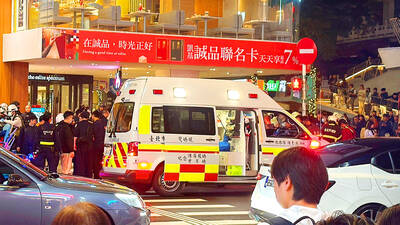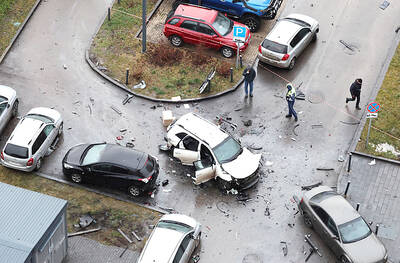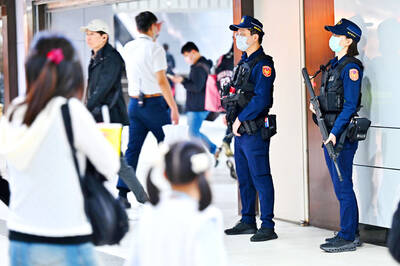The military balance in the Taiwan Strait continues to tilt in China's favor, with the pace of its missile deployment opposite Taiwan accelerating and an intensive effort by China that aims to prevent the US from coming to Taiwan's aid in the case of a Chinese attack, the Pentagon said in an annual report to the US Congress on Friday.
More than 900 short range ballistic missiles now face Taiwan and the number is increasing by more than 100 a year, the report, Military Power of the People's Republic of China 2007, calculates. That figure is up from an estimate of 710 to 790 such missiles contained in the Department of Defense's last report, which went to Congress last summer.
While last year's report pegged the missile buildup at "about" 100 a year, this year's puts it at "more than" that figure. The latest missile number was calculated last October, so the figure at present is likely to be much higher.
Over the past year, President Chen Shui-bian (
The annual report, mandated by Congress in a 2000 law, devoted several pages to Chinese efforts to prevent US forces from helping Taiwan fight off a Chinese attack, an area of concern that has occupied US military planners increasingly as PLA capacities have grown in recent years.
"In the near term, China is prioritizing measures to deter or counter third-party intervention in any future cross-strait crisis ... forces and operational concepts aimed at preventing an adversary from deploying military forces to forward operating locations," it said.
`Sustained effort'
The PLA "appears engaged in a sustained effort to develop the capability to interdict, at long ranges, aircraft carrier and expeditionary strike groups that might deploy in the western Pacific," it said.
"To prevent deployment of naval forces into Western Pacific waters, PLA planners are focused on targeting surface ships at long ranges ... to hold surface ships at risk through a layered defense" that would reach out beyond Guam, where the US is building up its main Pacific forces as it withdraws from Japanese bases, the report said.
Part of this would be an air defense component, using longer range surface-to-air missiles and the F-10, China's most advanced aircraft, and other advanced fighter jets.
Another aspect would be space warfare, as highlighted by the Chinese anti-satellite operation in January, in which a ground-based missile blew up an old weather satellite.
"China's space activities and capabilities, including anti-satellite programs, have significant implications for anti-access/area denial in Taiwan Strait contingencies and beyond," the Pentagon warned.
However, the Pentagon expressed confidence in the US ability to counter Beijing's efforts.
The US, "through the transformation of US armed forces and global force posture realignments, is maintaining the capability to resist any effort by Beijing to resort to force or coercion to dictate the terms of Taiwan's future status," the Pentagon said.
In its assessment of the Chinese threat to Taiwan, the report noted a number of important Chinese military advances over the past year that could boost its ability to attack Taiwan militarily and prevent or delay a US response in aid of Taiwan.
For example: China received its second Russian-made Sovremenny II guided missile destroyer, fitted with anti-ship cruise missiles and wide-area air defense systems, late last year.
It is building and testing second generation nuclear submarines, including ballistic missile subs and attack subs. Russia also delivered the last two of eight Kilo-class submarines equipped with supersonic anti-ship cruise missiles and sophisticated torpedoes.
Beijing's latest Luzhou class ships will be designed with surface-to-air missile systems that more than double the range of current PLA air defense systems.
China also began production of its first guided-missile frigate.
More than 700 Chinese combat aircraft are now within range of Taiwan without the need to refuel, and airport capacity can expand the number "significantly."
The Air Force is deploying the F-10 multi-role fighter to operational units. The F-10 will be "China's premier fighter in the coming decades."
Chinese aircraft are armed with "an increasingly sophisticated array of air-to-air and air-to-surface weapons, satellite and laser-guided precision munitions, and cruise missiles," the report said.
The PLA has deployed a new amphibious assault vehicle that "has greater stability and performance in open water. Increased amphibious training ... is building proficiency among China's amphibious forces," it said.
"China's military modernization and the deployment of advanced capabilities opposite the island have not eased, with the balance of forces continuing to shift in the mainland's favor," the report said. "Tensions could also increase as Taiwan prepares for its next presidential election."
The Pentagon takes some solace in the fact that Taipei appears ready to boost its defense spending after years of declining funding.

TRAGEDY STRIKES TAIPEI: The suspect died after falling off a building after he threw smoke grenades into Taipei Main Station and went on a killing spree in Zhongshan A 27-year-old suspect allegedly threw smoke grenades in Taipei Main Station and then proceeded to Zhongshan MRT Station in a random killing spree that resulted in the death of the suspect and two other civilians, and seven injured, including one in critical condition, as of press time last night. The suspect, identified as a man surnamed Chang Wen (張文), allegedly began the attack at Taipei Main Station, the Taipei Fire Department said, adding that it received a report at 5:24pm that smoke grenades had been thrown in the station. One man in his 50s was rushed to hospital after a cardiac arrest

A car bomb killed a senior Russian general in southern Moscow yesterday morning, the latest high-profile army figure to be blown up in a blast that came just hours after Russian and Ukrainian delegates held separate talks in Miami on a plan to end the war. Kyiv has not commented on the incident, but Russian investigators said they were probing whether the blast was “linked” to “Ukrainian special forces.” The attack was similar to other assassinations of generals and pro-war figures that have either been claimed, or are widely believed to have been orchestrated, by Ukraine. Russian Lieutenant General Fanil Sarvarov, 56, head

SAFETY FIRST: Double the number of police were deployed at the Taipei Marathon, while other cities released plans to bolster public event safety Authorities across Taiwan have stepped up security measures ahead of Christmas and New Year events, following a knife and smoke bomb attack in Taipei on Friday that left four people dead and 11 injured. In a bid to prevent potential copycat incidents, police deployments have been expanded for large gatherings, transport hubs, and other crowded public spaces, according to official statements from police and city authorities. Taipei Mayor Chiang Wan-an (蔣萬安) said the city has “comprehensively raised security readiness” in crowded areas, increased police deployments with armed officers, and intensified patrols during weekends and nighttime hours. For large-scale events, security checkpoints and explosives

PUBLIC SAFETY: The premier said that security would be tightened in transport hubs, while President Lai commended the public for their bravery The government is to deploy more police, including rapid response units, in crowded public areas to ensure a swift response to any threats, President William Lai (賴清德) said yesterday after a knife attack killed three people and injured 11 in Taipei the previous day. Lai made the remarks following a briefing by the National Police Agency on the progress of the investigation, saying that the attack underscored the importance of cooperation in public security between the central and local governments. The attack unfolded in the early evening on Friday around Taipei Main Station’s M7 exit and later near the Taipei MRT’s Zhongshan